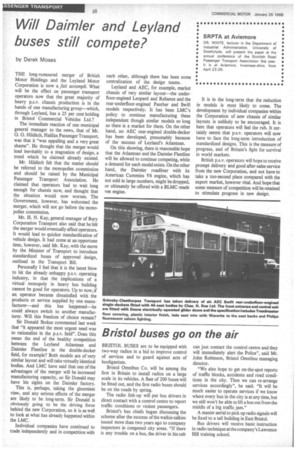Will Daimler and Leyland buses still compete?
Page 32

If you've noticed an error in this article please click here to report it so we can fix it.
by Derek Moses THE long-rumoured merger of British Motor Holdings and the Leyland Motor Corporation is now a fait accompli. What will be the effect on passenger transport operators now that the great majority of heavy p.s.v. chassis production is in the hands of one manufacturing group—which, through Leyland, has a 25 per cent holding in Bristol Commercial Vehicles Ltd.?
The immediate reaction of one municipal general manager to the news, that of Mr. G. G. Hilditch, Halifax Passenger Transport, was that it "was appalling and a very great shame". He thought that the merger would lead inevitably to a stagnation of design, a trend which he claimed already existed.
Mr. Hilditch felt that the matter should be referred to the monopolies commission and should be raised by the Municipal Passenger Transport Association. He claimed that operators had to wait long enough for chassis now, and thought that the situation would now worsen. The Government, however, has welcomed the merger, which will not go before the monopolies commission.
Mr. H. N. Kay, general manager of Bury Corporation Transport also said that he felt the merger would eventually affect operators. It would lead to quicker standardization of vehicle design. It had come at an opportune time, however, said Mr. Kay, with the move by the Minister of Transport to introduce standardized buses of approved design, outlined in the Transport Bill.
Personally I feel that it is the latest blow to hit the already unhappy p.s.v. operating industry, in that the implications of a virtual monopoly in heavy bus building cannot be good for operators. Up to now, if an operator became dissatisfied with the products or service supplied by one manufacturer—and this has happened—he could always switch to another manufacturer. Will this freedom of choice remain?
Sir Donald Stokes commented last week that "it appeared the most urgent need was to rationalize in the p.s.v. field". Does this mean the end of the healthy competition between the Leyland Atlantean and Daimler Fleetline in the double-decker field, for example? Both models are of very similar layout and will take virtually identical bodies. And LMC have said that one of the advantages of the merger will be increased manufacturing capacity, so Sir Donald may have his sights on the Daimler factory.
This is, perhaps, taking the gloomiest view, and any serious effects of the merger are likely to be long-term. Sir Donald is obviously going to be the driving force behind the new Corporation, so it is as well to look at what has already happened within the LMC.
Individual companies have continued to trade independently and in competition with each other, although there has been some centralization of the design teams.
Leyland and AEC, for example, market chassis of very similar layout—the underfloor-engined Leopard and Reliance and the rear-underfloor-engined Panther and Swift models respectively. It has been LMC's policy to continue manufacturing these independent though similar models so long as there is a market for them. On the other hand, no AEC rear-engined double-decker has been developed, presumably because of the success of Leyland's Atlantean.
On this showing, there is reasonable hope that the Atlantean and the Daimler Fleetline will be allowed to continue competing, while a demand for each model exists. On the other hand, the Daimler roadliner with its American Cummins Vb engine, which has not sold in large numbers, might be dropped, or ultimately be offered with a BLMC-made vee engine. It is in the long-term that the reduction in models is most likely to come. The development by individual companies within the Corporation of new chassis of similar layouts is unlikely to be encouraged. It is here that operators will feel the rub. It certainly seems that p.s.v. operators will now have to face the long-term introduction of standardized designs. This is the measure of progress, and of Britain's fight for survival in world markets.
British p.s.v. operators will hope to receive prompt delivery and good after-sales-service from the new Corporation, and not have to take a too-second place compared with the export market, however vital. And hope that some measure of competition will be retained to stimulate progress in new design.












































































































